
- •Contents
- •Contributors
- •1. Techniques for Liver MR Imaging
- •3. Contrast Agents for Liver MR Imaging
- •4. Imaging of Benign Focal Liver Lesions
- •5. Hepatic Pseudolesions
- •6. Imaging of Malignant Focal Liver Lesions
- •8. Comparison of Available Contrast Agents for the Imaging of Specific Liver Lesions
- •9. Imaging of Diffuse Liver Disease
- •10. MR Imaging of the Liver in Pediatric Patients
- •11. Imaging of the Liver Post-Surgery and/or Post-Ablative Therapy
- •12. MR Angiography in Liver Disease

11
Imaging of the Liver Post-Surgery and/or Post-Ablative Therapy
CONTENTS
11.1 |
Introduction |
1 1.2 |
Surgical Resection |
1 1.3 |
Radio-Frequency Ablation |
1 1.4 |
Laser-Induced Interstitial Therapy |
1 1.5 |
Cryotherapy |
1 1.6 |
Loco-Regional Drug Application |
11.6.1 |
Percutaneous Ethanol Injection |
11.6.2 |
Regional Transarterial Chemoembolization |
1 1.7 |
Multimodality Treatment of Hepatic Lesions |
being repeatable in cases of recurrent metastatic lesions [1].
Thermotherapeutic approaches to tumor reduction include the application of physical energy in radio-frequency (RF) ablation, laser-induced interstitial therapy (LITT) and cryotherapy. Chemotherapeutic approaches include the local instillation of drugs, alcohol injection, chemotherapeutic drug instillation and regional transarterial chemoembolization (TACE) [22].
11.1 Introduction
The liver is a common site of metastatic disease, which occurs following initial spread to the lymph nodes. It is the most common site of metastatic disease from primary cancer within the abdomen because it is the first major organ reached by venous blood draining from the intestinal tract. For patients with systemic spread of metastases, curative treatment is generally not possible and general chemotherapeutic approaches for treatment are indicated. On the other hand, if the liver remains the only site of metastatic disease, surgical resection may represent the only means of cure. Unfortunately, the average survival of patients with untreated hepatic metastases is between 2 and 8 months [19].
Only about 30% of patients with hepatic metastases represent cases suitable for surgical resection, even when intervention is performed in centers with expertise in hepatic surgery. Thus, there has been growing interest in interstitial approaches aimed at destroying liver metastases in situ. Local ablative therapeutic approaches include thermotherapy and chemotherapy and are alternatives to major surgery. Each of these has the advantage of
11.2
Surgical Resection
The role of surgical resection in the treatment of hepatic metastases of primary colorectal carcinomas is well-recognized and may contribute to the five year survival of 25% to 37% of affected patients [9]. However, the approach to the surgical treatment of hepatic metastases from primary tumors other than colorectal cancer is less obvious, and is highly dependent upon the type of primary tumor. Nevertheless, a reported five year survival rate of 21% after resection of metastases from non-colorectal carcinomas can be considered comparable to that for metastases from colorectal carcinomas [12]. While outstanding results are obtained when metastases from neuroendocrine tumors are resected, less favorable results are frequently obtained from the resection of metastases from gastric or breast cancer.
As only about 30% of the patient population with hepatic metastatic disease is eligible for liver resection, preoperative magnetic resonance imaging (MRI) provides detailed information for surgical therapy planning, as it can help determine the number and location of intrahepatic lesions [32]. Exact anatomic description of the tumor spread in correlation with the segmental distribution and the course of major hepatic vascular structures is es-
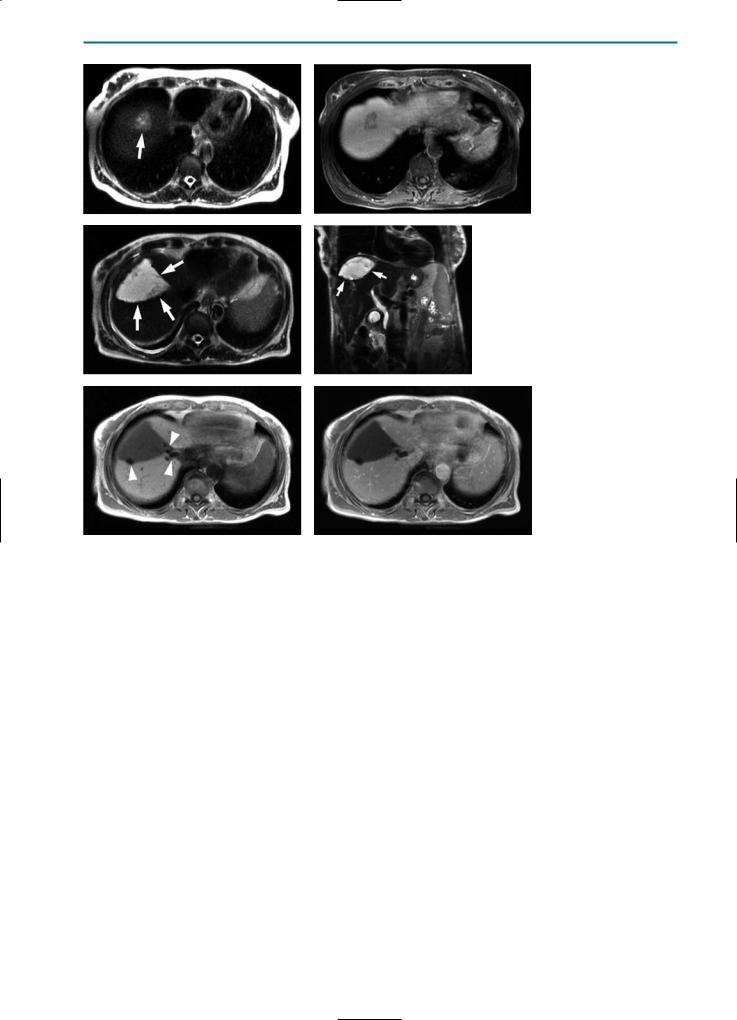
372 MRI of the Liver
a |
b |
c |
d |
e |
f |
Fig. 1a-f. Preand post-surgical imaging in a patient with liver metastases from colorectal cancer and postoperative bilioma formation. The preoperative imaging studies show a metastasis with high SI on the T2-weighted image (a, arrow) and typical peripheral wash-out on the contrast-enhanced T1-weighted fat-suppressed image post-injection of Gd-BOPTA (b). On post-surgical imaging, three weeks after resection of the liver metastases (c-f), a triangular defect from atypical resection of the lesion is visible on axial (c) and coronal (d) T2-weight- ed HASTE images (arrows). The resulting defect is filled with a high SI fluid, which aspiration showed to be a bilioma formation. Note susceptibility artifacts from surgical clips on the unenhanced T1-weighted image (e, arrows). In the equilibrium phase post-contrast agent injection (0.05 mmol/kg BW Gd-BOPTA) no enhancing rim surrounding the defect is visible, which excludes an inflammatory process or abscess formation
sential. Infiltration of central hilar vascular structures such as the portal vein, hepatic artery and central hepatic bile ducts almost always excludes a possible treatment by liver resection. Moreover, extrahepatic tumor growth and infiltration into adjacent organs should be carefully evaluated.
Post-operative MRI of the liver within the first four weeks is helpful for the detection of surgical complications such as hematoma or abscess formation, perfusion disturbances or bilioma formation. Bilioma or abscess formations are characterized by a hypoto hyperintense signal on T1weighted images and by typically high signal intensity on T2-weighted images. A lack of central enhancement is seen both with bilioma and abscess formations, however if a pronounced peripheral enhancement, indicating an abscess wall, can be identified, the patient may require interventional drainage or surgical revision (Fig. 1). As regards
bilioma formations, follow-up studies are advised since some bilioma formations resolve spontaneously with time. In the case of port-surgical biliary leaks, the precise location of the leak can frequently be accertained with the use of MR contrast agents such as Gd-BOPTA that are excreted in part through the hepatobiliary system. In this regard, T1-weighted images acquired during the hepatobiliary phase at around 2h after injection will usually reveal the location of the leak through contrast extravasation at the site of bile duct damage.
In most cases, surgical resection involves the removal of two or more liver segments and postsurgical follow-up imaging does not differ greatly from pre-surgical imaging. However, if the borders of the resected liver lesions are within 2 cm of the resection margin, special attention should be paid to the neighboring areas at follow-up. Using T1-weighted imaging, detailed evaluation of the
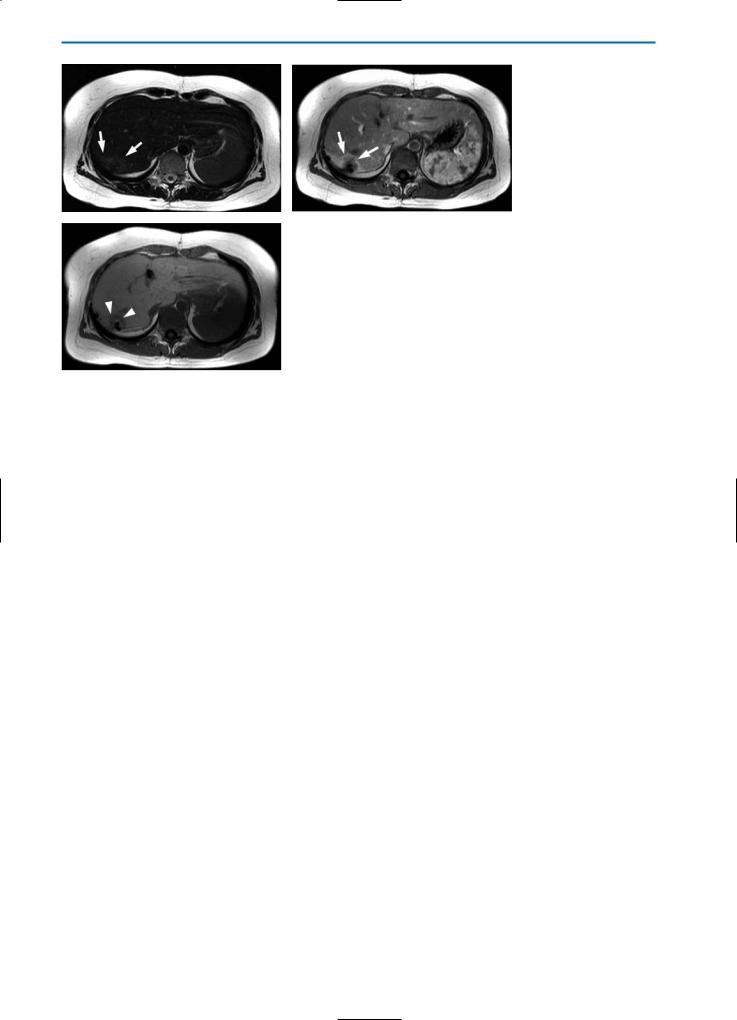
11 • Imaging of the Liver Post-Surgery and/or Post-Ablative Therapy |
373 |
a |
b |
Fig. 2a-c. Recurrent tumor after atypical liver resection. On the unenhanced T2weighted TSE image (a), an area of slightly increased SI surrounds the resection defect (arrows). On the T1-weighted arterial phase image (b) after bolus injection of contrast agent (0.05 mmol/kg BW Gd-BOPTA), an irregular shaped margin of increased enhancement is visible (arrows), which is separated by a tissue rim from the resection defect. This rim of tissue represents recurrent tumor which on the hepatobiliary phase T1-weighted image (c) 1 hour after contrast agent administration,
cshows no uptake of contrast agent. This indicates a recurrent tumor rather than just a post-surgery perfusion abnormality
resection margins is sometimes difficult due to susceptibility artifacts caused by surgical clips (Fig. 1e). Follow-up evaluations may also be difficult in cases of atypical resection. Likewise, when liver lesions are enucleated with a margin of 2-3 cm a clear identification of the resection margins may not always be possible. Additionally, signal intensity on unenhanced T1-weighted and T2weighted images as well as on T1-weighted dynamic imaging may be influenced by hemorrhage, seroma formation, inflammation and ischemia of surrounding liver tissue, particularly during the first one to two months after resection. Thus fol- low-up imaging is usually best performed at three or more months after resection, in order to minimize the influence of post-surgical changes. In such cases, hyperintense nodular regions on T2weighted images, hypointense areas on unenhanced T1-weighted images and irregular vascularization on T1-weighted dynamic images is usually indicative of a recurrent tumor (Fig. 2). Since the majority of patients develop recurrent metastases after surgical resection, careful restaging is mandatory.
Furthermore, in post-surgical follow-up imaging, special care should be taken to detect intrahepatic or intraperitoneal seeding of tumor cells from surgery. This is particularly important in instances of atypical resection of liver metastases.
11.3
Radio-Frequency (RF) Ablation
RF ablation of focal liver lesions uses an alternating current at frequencies above 250 kHz, induced
by monoor bipolar probes. This is used to generate heat and thus destroy tissue without causing stimulation of nerves or muscles. The slow application of electrical energy with low current density leads to the heating and eventual dehydration of cells and, thereafter, to the degeneration of collagenous structures and proteins [6].
Multiple probe arrays or cooled-tip RF electrodes with 2-3 cm of exposed metal tip, both of which are connected to a frequency generator (up to 200 Watts), are usually used to deliver the RF energy to the tissue. During the ablation procedure, a thermocouple measures the local temperature, and tissue impedance is monitored continuously while the generator output is increased slowly to 950 - 1100 mA. Careful monitoring is necessary in order to prevent the tissue from boiling and subsequently carbonizing. Thus, if the impedance increases by > 10 Ohm, the current needs to be reduced until stable impedance is again observed [5]. The standard RF application generally lasts for 12-25 minutes and results in typical coagulation necrosis diameters of 2.5-3.7 cm. The maximum diameter reached is 7 cm [18, 33].
Histologically, ablated areas consist of necrotic tumor tissue surrounded by necrotic liver tissue. The safety margin of surrounding necrotic liver tissue should have a thickness of > 1 cm, corresponding to the surgical resection borders. This zone is encircled by a homogeneous rim of edematous inflammatory tissue of variable thickness, which is maximal at about two weeks after the intervention [34].
In cases of complete tumor destruction, T2weighted MR images acquired post-RF ablation typically show an area of low signal intensity
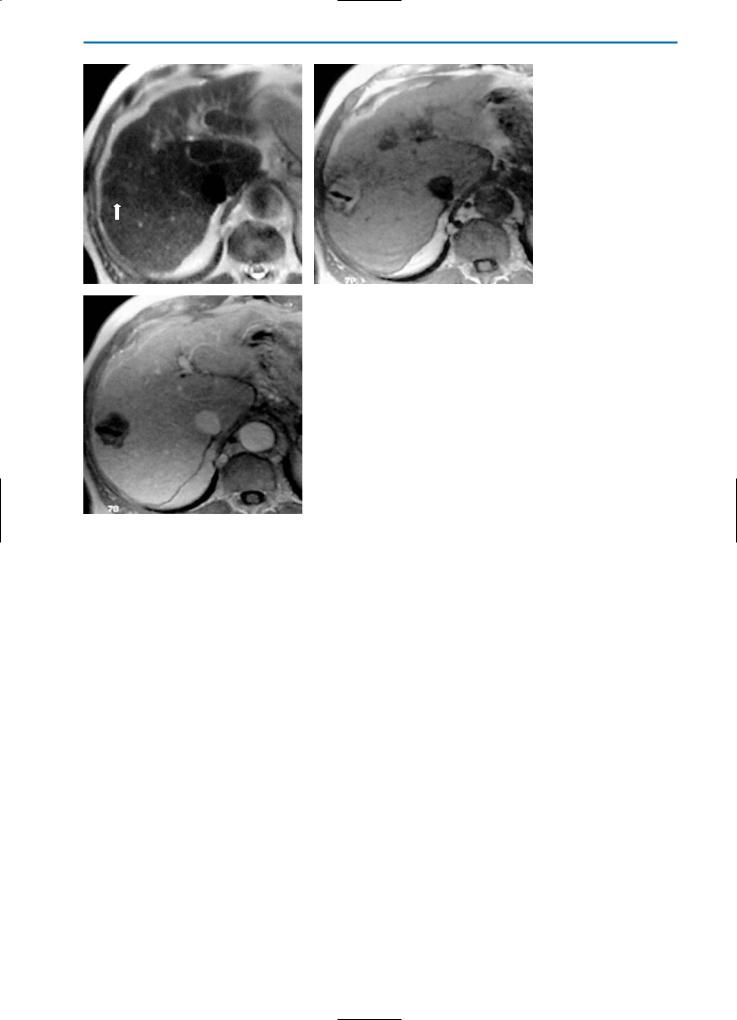
374 MRI of the Liver
a |
b |
Fig. 3a-c. Patient with liver metastases from colon cancer treated with radio-fre- quency (RF) ablation. Due to diffuse coagulative necrosis, the RF-lesion (arrow) appears slightly hypointense on the T2-weighted image (a) and slightly hyperintense on the T1-weighted image (b). No enhancement of the RF-lesion is seen during the
cequilibriumstruction phase after Gd-BOPTA administration (c), indicating complete tumor de-
which corresponds to necrotic tumor and liver tissue. A hyperintense rim encircling this area represents edematous liver and granulation tissue. Conversely, treated lesions typically present as hyperintense with a hypointense rim on unenhanced T1-weighted images (Fig. 3). In the equilibrium phase following the injection of an extracellular Gd-chelate, T1-weighted images of completely destroyed liver lesions reveal a hypointense, non-per- fused central area that is surrounded by a thin hyperintense rim (Fig. 4). The increased peripheral enhancement in completely destroyed liver lesions reflects the inflammatory reaction as well as sinusoidal obstruction and portal-venous perfusion at the edge of the ablated area. Typically, the peripheral wash-out that is characteristic of viable liver metastases, is not observed in completely RF-de- stroyed liver metastases.
On the other hand, if hyperintense irregular or nodular foci are detected on T2-weighted images, together with irregularity or interruption of the enhancement at the boundaries, or enhancement within the lesion on post-contrast T1-
weighted images, this could indicate residual tumor or local tumor regrowth. Similarly, signs of peripheral wash-out in areas of the RF ablation should be interpreted as possible tumor regrowth or residual tumor tissue (Fig. 5). Wedged-shaped arterial perfusion as an expression of arterioportal shunting can sometimes complicate the evaluation of the surrounding normal liver tissue [35].
Commonly described complications of RF ablation are: hemorrhage, central bile duct injury, intraperitoneal abscess formation and, rarely, burning injuries of adjacent organs such as bowel, stomach or kidney. Due to the high sensitivity of MR imaging, major complications are easily detected.
Hemorrhage is detected on T1-weighted fat supressed images with intermediate to high SI depending on when the bleeding occurred. In RF ablation special attention should be paid not only to complications such as hemorrhage and inflammation, but also to intrahepatic diffusion of the tumor and to seeding along the puncture canal within the liver and abdominal wall.
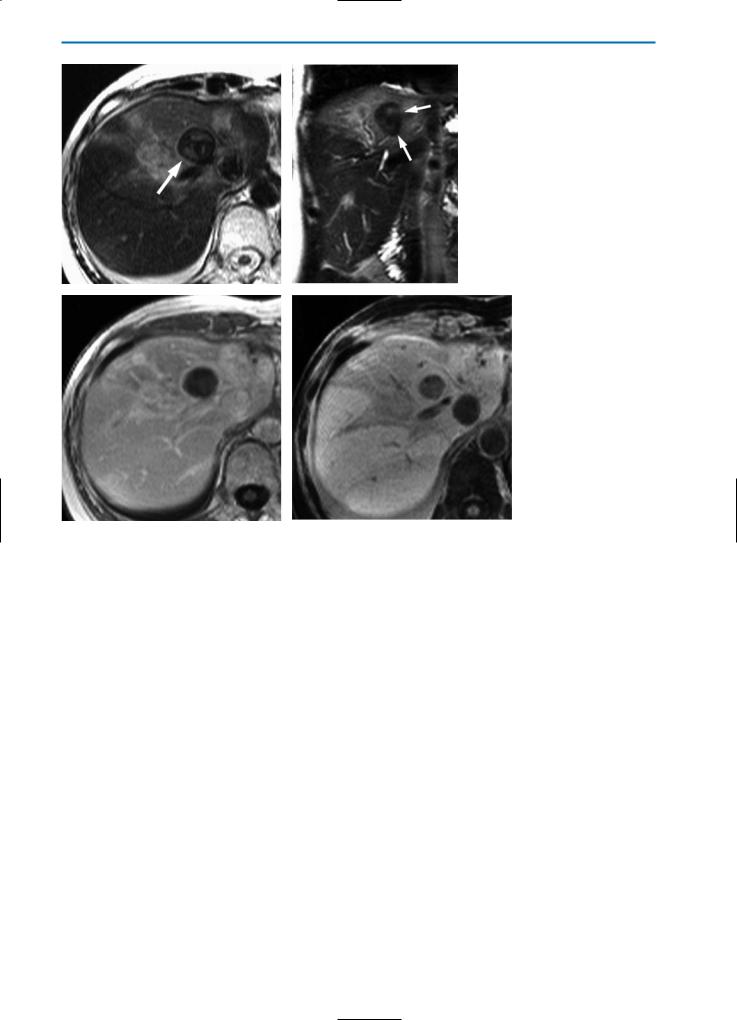
11 • Imaging of the Liver Post-Surgery and/or Post-Ablative Therapy |
375 |
a |
b |
c |
d |
Fig. 4a-d. Patient with solitary metastasis of breast cancer treated with radio-frequency (RF) ablation. Imaging was performed three days after ablation. On the unenhanced T2-weighted HASTE images in axial (a) and coronal (b) orientation, the RF-lesion (arrows) shows a low SI, surrounded by a rim of even lower SI. Note the inflammation of the surrounding liver parenchyma, which has an increased SI. These changes are most likely caused by impairment of hepatic perfusion due to RF-ablation. In the equilibrium phase (c) after contrast agent injection (0.05 mmol/kg BW Gd-BOPTA), T1-weighted images show a closed, hyperintense rim surrounding the lesion. The lesion itself demonstrates no enhancement, indicating complete tumor destruction. In the hepatobiliary phase one hour after Gd-BOPTA administration (d), heterogeneous contrast agent uptake of the liver tissue surrounding the RF-lesion is demonstrated, the lesion shows no enhancement and is sharply demarcated from the surrounding liver
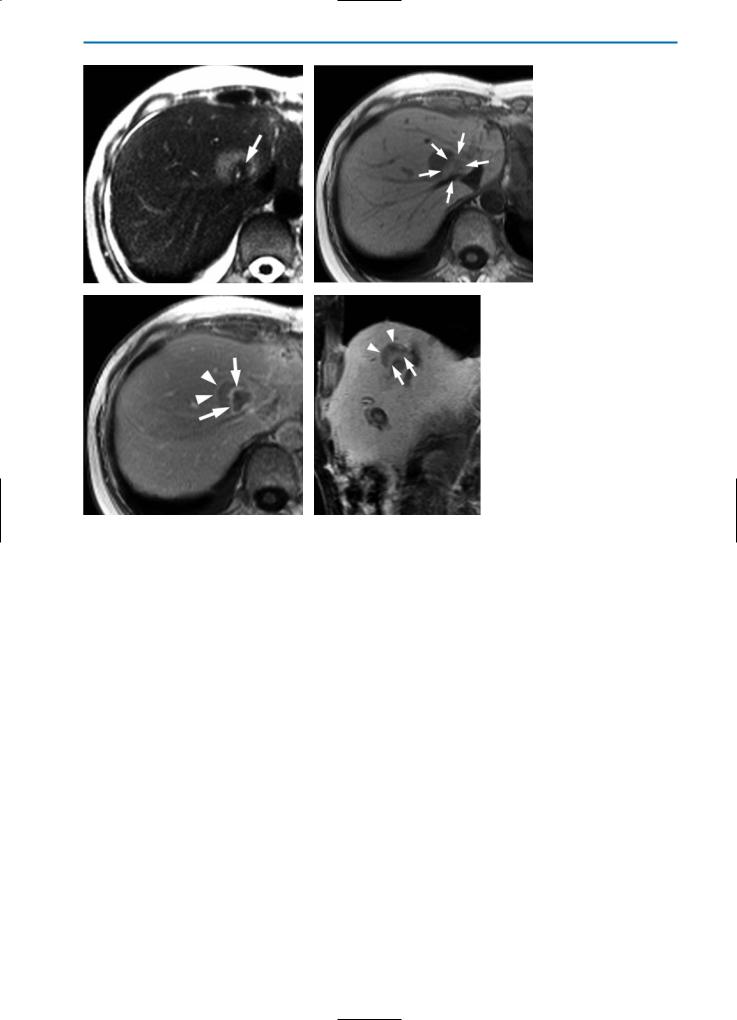
376 MRI of the Liver
a |
b |
c |
d |
Fig. 5a-d. Incomplete RF-ablation of a liver metastasis from colorectal carcinoma. The unenhanced T2-weighted HASTE image (a) shows tissue with increased SI surrounding the hypointense RF-lesion (arrow). On the corresponding T1-weighted image (b) the RF-lesion has a slightly increased SI (arrows), whereas the residual tumor tissue is depicted with a low SI. After contrast agent injection (0.05 mmol/kg BW Gd-BOPTA) the T1-weighted equilibrium phase image (c) shows a hyperintense rim surrounding the RF-lesion (arrows). Similarly a rim separates the residual tumor tissue from the surrounding liver parenchyma (arrowheads). A coronal T1-weighted fat-suppressed image in the hepatobiliary phase after contrast agent injection (d) clearly demonstrates residual tumor tissue (arrowheads) separated from the RF-lesion by a hyperintense rim (arrows)
11.4
Laser-Induced Interstitial Therapy (LITT)
Interstitial laser-induced hyperthermia is based on the conversion of laser light into heat. This is typically performed using a Nd:YAG laser at a wavelength of 1064 nm. The technique involves the invasive insertion of a laser catheter into the lesion using a light-conducting quartz fiber. To avoid early carbonization around the tip of the optic fiber, a closed cooling system based on circulating saline solution decreases the temperature peak around the applicator tip [23]. The success of the treatment is highly dependent upon the optimal positioning of the laser applicator in the center of the lesion. Hence, precise monitoring during therapy is mandatory. The conversion of laser light into heat in LITT results in cell death followed by coag-
ulative necrosis and secondary degeneration. Subsequent atrophy results in tumor shrinkage with minimal damage to surrounding structures. During the procedure, monitoring of thermo-induced signal changes in the treated tissue is possible on the basis of T1-weighted fast low angle GRE sequences in which a rise of the temperature is represented by a signal decrease [24].
The size of the heated volume depends on the power of the laser, the irradiation time and the optical and thermal characteristics of the treated tissue. Frequently, lesions with a diameter of up to 5 cm can be treated successfully [21].
T2-weighted MR images acquired approximately two to three months after LITT intervention typically reveal a hyperintense lesion surrounded by a hypointense rim. No enhancement of the lesion should be seen on T1-weighted equilibrium phase images acquired after injection of a Gd-chelate (Fig. 6).
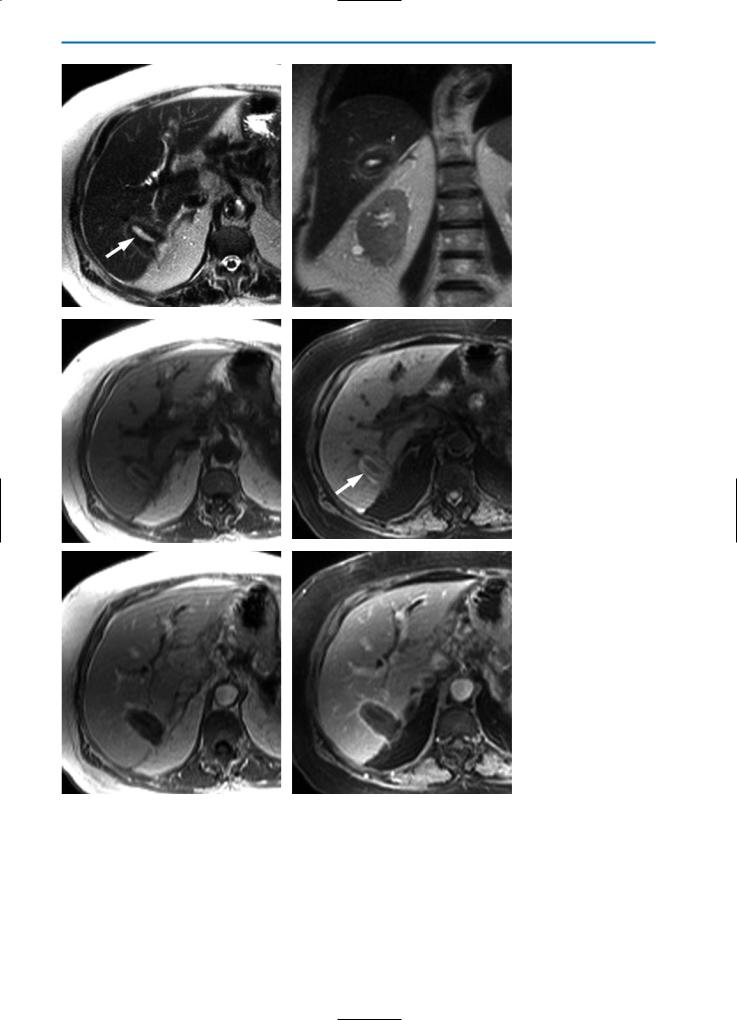
11 • Imaging of the Liver Post-Surgery and/or Post-Ablative Therapy |
377 |
a |
b |
c |
d |
|
e |
f |
Fig. 6a-f. Patient with metastases from colorectal cancer treated by LITT intervention. The T2-weighted HASTE images in axial (a) and coronal (b) orientation demonstrate a hyperintense lesion (arrow), surrounded by some hypointense tissue which again is demarcated from the normal liver parenchyma by a hyperintense rim. On the corresponding T1-weighted (c) and T1-weighted fat suppressed images
(d) the more peripheral parts of the lesion show signs of hemorrhage (arrow in d). On T1-weighted (e) and T1-weighted fat suppressed (f) images, acquired during the equilibrium phase after contrast agent injection, the lesion is distinguished from surrounding liver tissue by a hyperintense rim. The absence of contrast agent uptake in the center of the lesion indicates complete tumor destruction

378 MRI of the Liver
Local tumor recurrence should be considered if T2-weighted images reveal nodular areas of medium to high signal intensity within the hypointense rim surrounding the lesion, or if nodular regions within the hyperintense necrosis, which differ from the signal intensity of the necrosis itself, can be detected. The same applies for contrast-en- hanced T1-weighted images in which recurrent tumor growth is indicated if enhancement is seen in central areas of the lesion or if enhancing peripheral nodular structures are detected [2, 23, 25].
11.5 Cryotherapy
Cryosurgery is defined as local tumor destruction in situ caused by the rapid freezing of tumor cells. Cryosurgery was introduced as an ablative technique mainly in patients with prostatic malignancies and, in some centers, also for the treatment of patients with liver metastases and primary liver tumors such as hepatocellular carcinoma (HCC).
Since cryotherapy does not destroy the walls of large vessels such as the inferior caval vein or large liver veins and portal branches, this approach is particularly well-suited to the treatment of unresectable lesions located near these vessels.
Frequently, resection and cryotherapy are combined during a single invasive procedure. Moreover, cryosurgery is appropriate as an adjunct to liver surgery (so-called “edge cryotherapy”) in cases in which a very close or histological-positive resection margin is anticipated. During this procedure, flat cryoprobes are positioned at the resection edge of the remaining liver and adequate freezing is performed to a depth of at least 1.5 cm into the liver tissue.
The mechanism of tumor cell destruction in cryotherapy depends on the location of the tumor tissue in relation to the cryoprobe. In areas close to the cryoprobe temperatures rapidly fall to –190 °C, causing ice crystals to form within and around the cells. Subsequent thawing and rehydration results in rupture of the cell membrane and hence tissue death. At distances slightly further from the cryoprobe, the temperature drops more slowly and ice forms within the small vessels. Since cell membranes impede intracellular ice crystal formation in this case, the parenchymal cells dehydrate to equilibrate the resulting chemical gradient. This results in cellular disintegration and expansion of the blood vessels, which rupture upon thawing, resulting in tissue hypoxia. Thus, cell death in cryotherapy is a combination of intraand extracellular ice crystal formation, cellular dehydration, rupture of small vessels and hypoxia from small vessel destruction [10, 20]. Cellular damage can be increased by re-
peated application of consecutive freeze-thaw cycles [28].
Cryotherapy within the liver has experienced a renaissance with the availability of intraoperative ultrasound (US) as a real-time control for the ablative procedure. Nevertheless, the expansion of the forming ice ball cannot be detected opposite the ultrasound transducer, since the ice front orientated towards the transducer builds a reflection wall with a “shadow zone” behind it [26]. MR imaging can overcome this disadvantage, showing excellent contrast between ice formation and unaffected perfused liver tissue on the basis of decreased T2 relaxation time of the frozen tissue [27].
As a result of the histopathologic changes, lesions after cryotherapy may show signs of hemorrhage on unenhanced T1-weighted and T1-weight- ed fat-suppressed images and appear hyperor rarely isointense on T2-weighted images. On con- trast-enhanced T1-weighted images, the destroyed tissue is seen as a hypovascular region. In cases of complete tumor destruction, contrast-enhanced T1-weighted images acquired during the equilibrium phase reveal a hypointense lesion typically surrounded by a closed hyperintense rim, most likely formed by fibrovascular granulation tissue (Figs. 7, 8). If this rim is interrupted, the site of the interruption should be considered as indicating residual or recurrent tumor, since typically neither a homogeneous rim nor evidence of edema is seen in unaffected tumor tissue. Often the size of the resulting cryo-lesions remains relatively stable for three to six months. Thereafter lesions begin to shrink until they are either no longer visible or can be identified only by the presence of a small scar (Fig. 9) [2, 26].
11.6
Loco-Regional Drug Application
11.6.1
Percutaneous Ethanol Injection (PEI)
Several studies have shown that PEI is an effective alternative to surgery in cases of small HCC. Tumor cell destruction is achieved by alcohol-in- duced immediate coagulative necrosis of the affected tissue as a consequence of protein denaturation and cellular dehydration [16].
The maximum diameter of HCC lesions that can be treated successfully by PEI is approximately 3 cm. Larger lesions are less amenable to treatment with this technique because the ethanol distributes less homogeneously, resulting in incomplete necrosis of the lesion. This applies equally for the treatment of liver metastases where PEI is of limited effectiveness for local tumor control [8].
T2-weighted MR images acquired post-PEI

11 • Imaging of the Liver Post-Surgery and/or Post-Ablative Therapy |
379 |
typically demonstrate areas of markedly decreased signal intensity, corresponding to regions of ethanol-induced coagulative necrosis. The possibility of tumor recurrence should be considered if an area of increased signal intensity is observed within the lesion. However, in rare cases, necrosis with high signal intensity may be observed in the center of the lesion. This is indicative of liquefactive necrosis and should be borne in mind for differential diagnosis.
Contrast-enhanced T1-weighted images in the equilibrium phase reveal a hypovascular area.
Recurrent or residual tumor should be considered if enhancement is detected within three to six months post-therapy (Fig. 10) [11, 17]. In cases of treated HCC, special attention should be paid to early enhancing areas in the arterial phase of the dynamic series of acquisitions since early enhancement is highly indicative of recurrent tumor.
On post interventional T1-weighted images a fan-shaped hypointense area of normal liver tissue adjacent to the treated HCC with a corresponding hyperintense signal on T2-weighted images can sometimes be observed and might be mistaken for residual tumor. This area, which typically enhances strongly on T1-weighted images after administration of contrast agent, represents pathologic changes in the normal liver tissue as a toxic reaction to the injected ethanol.Awareness of such abnormalities is important for the correct evaluation of therapeutic efficacy [29].
11.6.2
Regional Transarterial Chemoembolization (TACE)
Neither systemic or local chemotherapy nor chemoembolization are primary techniques normally used with the aim of curing liver metastases. They are mainly considered a second-line treatment in patients with metastases of colorectal carcinoma.
On the other hand TACE is frequently used for curative treatment of HCC, especially in Asia.
TACE therapy is based on the differential blood supply of normal liver tissue and hepatic tumors. Whereas arterial perfusion accounts for about 25% of the blood supply in normal liver parenchyma, it may account for as much as 95% in hepatic neoplasms, depending on the histology of the tumor. Thus, solid liver tumors are frequently accessible to arterial embolization and/or intraarterially applied chemotherapy, while surrounding liver tissue is not affected to the same extent due to its mainly portal venous blood supply. The direct superselective arterial application of chemotherapeutics leads to an increased concentration of the chemotherapeutic drug within the
lesion with a concomitant reduction of systemic side effects [3].
Typically, chemoembolization involves the injection of an emulsion of iodized oil (e.g. lipiodol) followed by a chemotherapeutic drug (e.g. doxorubicin) and embolization particles applied via an arterial catheter that is advanced into the segmental or subsegmental arteries that feed the tumor tissue.
Chemoembolization may lead to a partial reduction of tumor volume which may secondarily allow surgical resection or interventional ablation in the case of inaccessible tumors. Frequently it is performed in cases in which systemic chemotherapy is ineffective and in cases of therapy-resistant pain arising from dilatation of the liver capsule [21, 30].
TACE is generally contraindicated in a number of situations: when significant reduction of synthetic liver function is apparent, when 75% or more of the liver tissue is affected by the neoplasm, in cases of ascites where the Karnowski Index is less than 50%, and in cirrhotic livers when the liver parenchyma unaffected by the tumor has an increased arterial supply. Additionally, TACE may only be performed in cases of portal-venous obstruction if sufficient collaterals are present [14].
MRI is increasingly being used for follow-up studies in patients after injection of iodized oil. MRI is generally preferred to computed tomography (CT) for post-TACE imaging since the high concentration of lipiodol within the tumor can make it very difficult to recognize possible disease recurrence on CT imaging. This is due to the hyperdensity of lipiodol which tends to mask the hypervascular areas of residual or recurrent tumor which are also hyperattenuating after injection of iodinated contrast material [13, 31].
Follow-up imaging after TACE is possible between the first week and approximately two to three months after the procedure. If T1-weighted dynamic imaging is performed within the first week after TACE, the increased signal intensity seen in tumor nodules that accumulate lipiodol can sometimes make it difficult to detect residual hypervascular tumor tissue (Fig. 11). On the other hand, persistent lipiodol retention for more than four weeks indicates therapeutic effectiveness. Decreased signal intensity on T2-weighted images may also be observed within one week of treatment. However, remaining areas of higher signal intensity on T2-weighted images may not necessarily indicate residual tumor tissue, since the T2 relaxation time is also influenced by early concomitant modifications, such as ischemia, hemorrhage, edema and initial colliquative necrosis [4, 31].
Whereas early follow-up after TACE is often inconclusive for the detection of recurrent tumor, follow-up T2-weighted and arterial phase con-
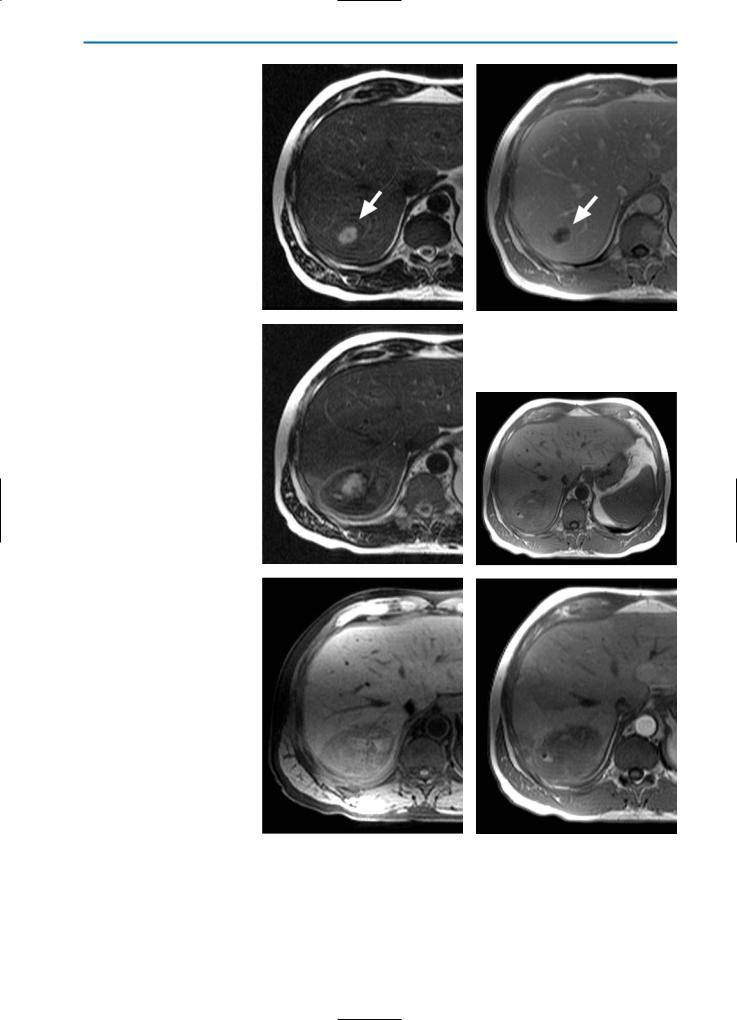
380 MRI of the Liver
a |
b |
c |
d |
e |
f |
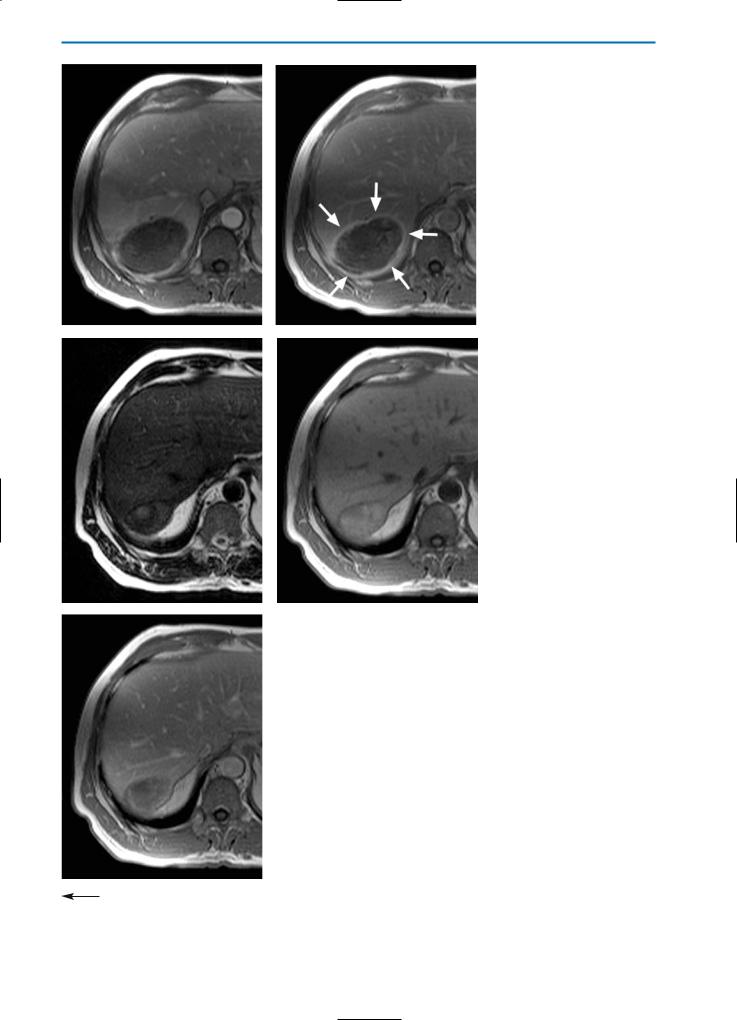
11 • Imaging of the Liver Post-Surgery and/or Post-Ablative Therapy |
381 |
g |
h |
i |
j |
Fig. 7a-k. Liver lesions post-cryotherapy / no residual tumor. Pre-cryotherapy, the T2weighted (a) and contrast-enhanced T1-weighted equilibrium phase (b) images show a partially necrotic metastasis of colorectal cancer (arrows). One week after cryotherapy, the T2-weighted image (c) shows a partially hyperintense, partially hypointense region surrounded by a high SI rim. On the corresponding T1-weighted (d) and T1-weighted fatsuppressed (e) images, high SI areas within the cryolesion can be detected, indicating hemorrhage. Dynamic imaging in the arterial phase (f) reveals segmental hypervascularization of the affected liver segment, which is even more obvious in the portal-venous phase (g). However, no peripheral enhancement of the cryolesion is detected, indicating no residual tumor. In the equilibrium phase (h) a closed hyperintense rim (arrows) surrounding the lesion is observed without any enhancement of central areas. This indicates complete destruction of the tumor tissue.
A T2-weighted image acquired six months after cryotherapy (i) shows that the cryolesion still has heterogeneous, partially high SI. On the corresponding T1-weighted image (j), heterogeneously high SI can be observed. On contrast-enhanced images in the equilibri-
kum phase (k), enhancement of the central areas of the lesion is still not visible and a closed hyperintense rim surrounding the lesion can still be seen
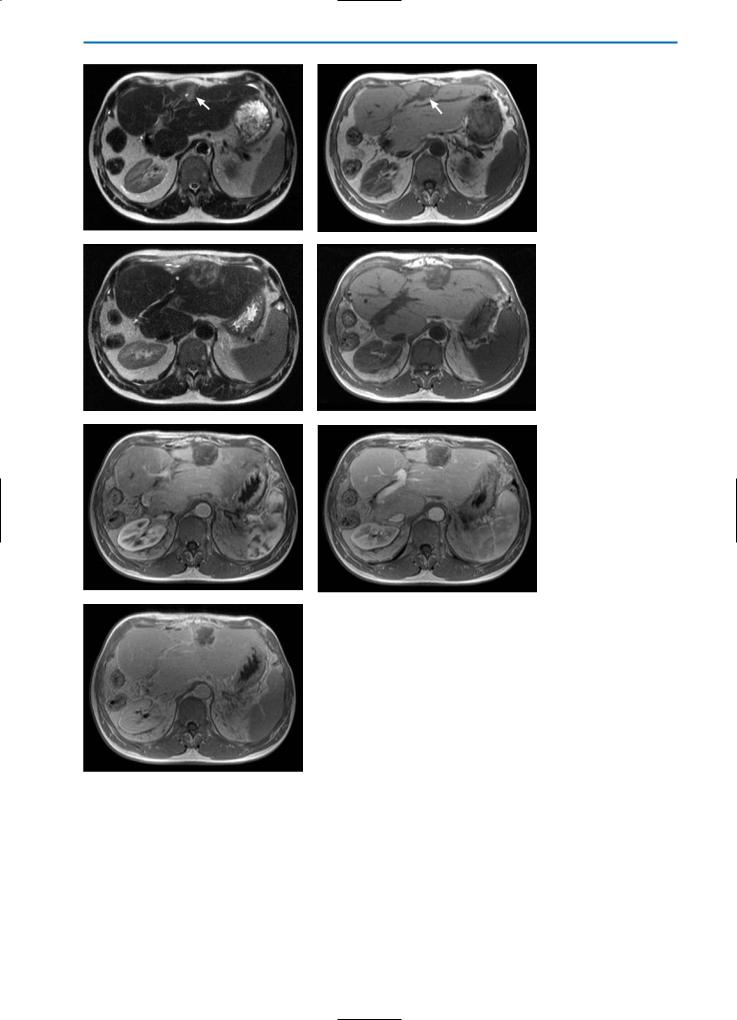
382 MRI of the Liver
a |
b |
c |
d |
e |
f |
g
Fig. 8a-g. Liver lesion post-cryotherapy showing no residual tumor in a patient with previous liver resection.
On the unenhanced T2-weighted (a) and T1-weighted (b) images pre-cryotherapy, a metastasis (arrows) can be seen in the left liver lobe. Note that the patient underwent previous right hemi-hepatectomy. The T2-weighted image (c) acquired one month following cryotherapy, shows a heterogeneous, predominantly high SI lesion. On the T1-weighted image (d), this lesion is hypointense with some high SI areas indicative of hemorrhage. On dynamic imaging, segmental hypervascularization can again be noted in the arterial phase (e) with homogeneous signal in the portal-venous phase (f). The equilibrium phase image (g) again shows a closed hypervascular rim surrounding the lesion, indicating complete destruction of the metastasis
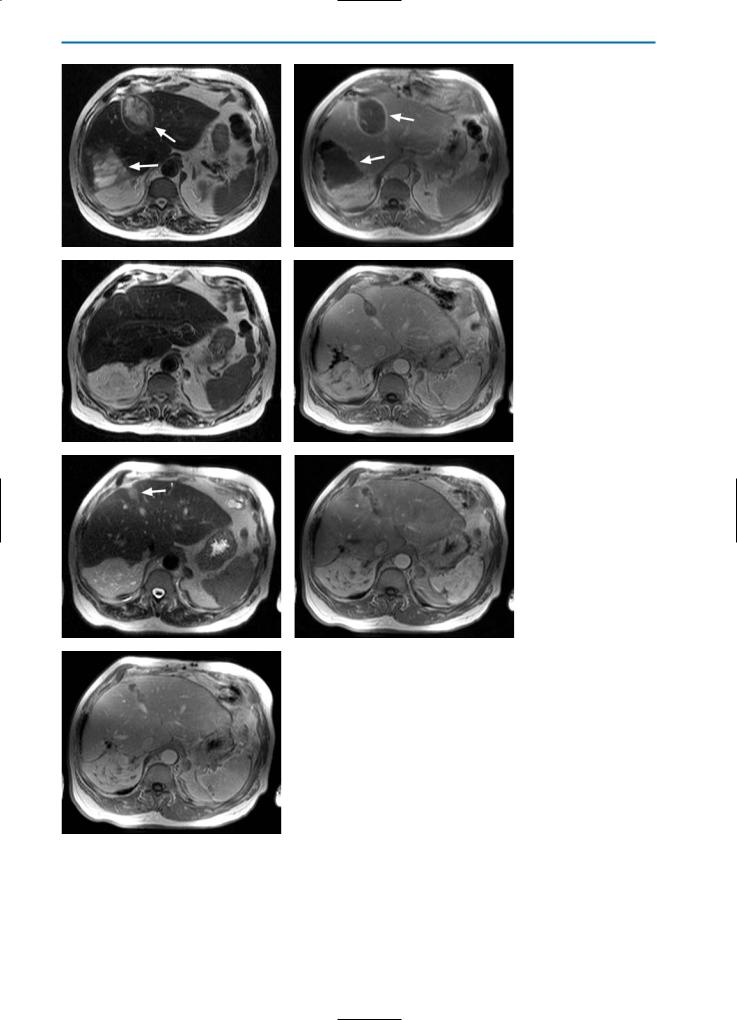
11 • Imaging of the Liver Post-Surgery and/or Post-Ablative Therapy |
383 |
a |
b |
c |
d |
e |
f |
g
Fig. 9a-g. Patient post-cryotherapy demonstrating late recurrent disease. T2-weighted (a) and contrast-enhanced T1-weighted equilibrium phase (b) images acquired three weeks after cryotherapy show two large cryolesions (arrows). Hyperintense rims surrounding the lesions are apparent on the T1-weighted equilibrium phase image (b). Significant reduction of the size of the cryolesion can be noted on both T2-weighted (c) and contrast-enhanced T1-weighted equilibrium phase (d) images acquired six months post-cryotherapy. No signs of residual tumor or local recurrence are apparent. However, on a T2-weighted image acquired 12 months post-cryotherapy (e), again a homogeneous high SI lesion (arrow) in the area of one of the former cryolesions can be seen. On the corresponding T1-weighted image in the arterial phase after contrast agent injection (f), an irregular peripheral enhancement of the affected region is evident. In the equilibrium phase (g), no hyperintense rim can be observed. Taken together, these observations indicate local recurrent disease
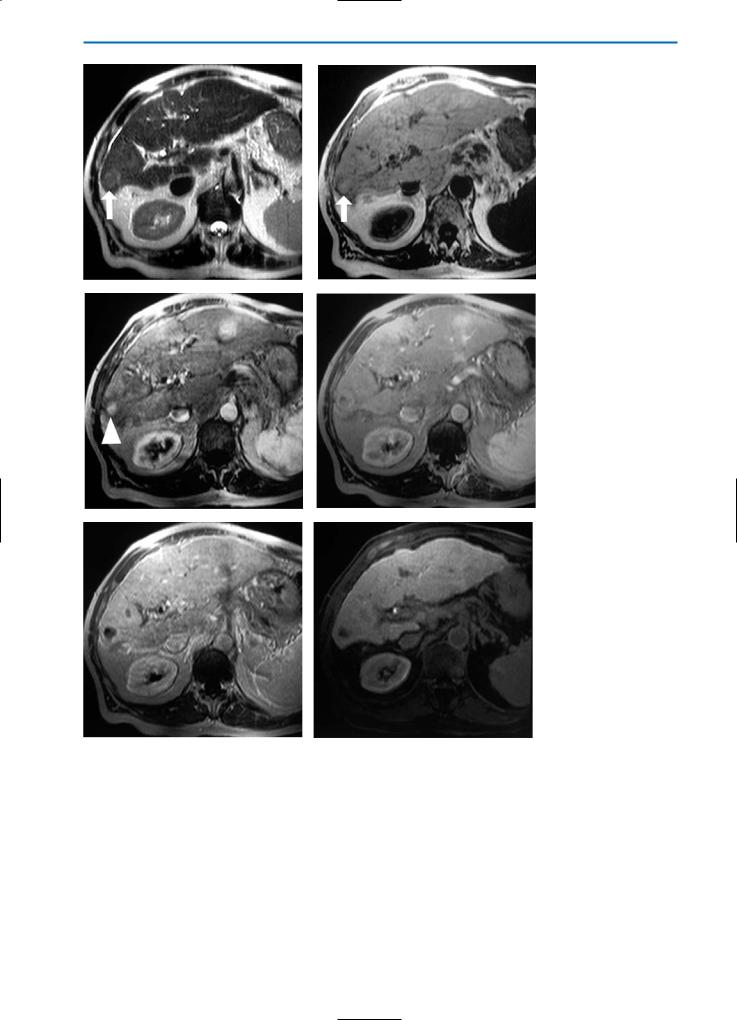
384 MRI of the Liver
a |
b |
c |
d |
e |
f |
Fig. 10a-f. HCC post-percutaneous ethanol injection (PEI) / residual tumor. The nodule (arrow) appears hypointense with slightly hyperintense peripheral areas on the T2-weighted image (a) and hyperintense on the T1-weighted image (b) after PEI treatment. A focal hypervascular area (arrowhead), representing focal residual tumor, is seen during the arterial phase after the bolus injection of Gd-BOPTA (c). The portal-venous and equilibrium phase images (d and e, respectively) reveal contrast agent wash-out from the residual tumor and an overall hypointense appearance. The delayed hepatobiliary phase image (f) indicates that the residual tumor does not significantly take up Gd-BOPTA. This case is typical of residual tumor in HCC treated by percutaneous ethanol injection. The arterial phase image after contrast agnet injection is most sensitive for the detection of residual or recurrent tumor in cases of HCC or other hypervascular lesions
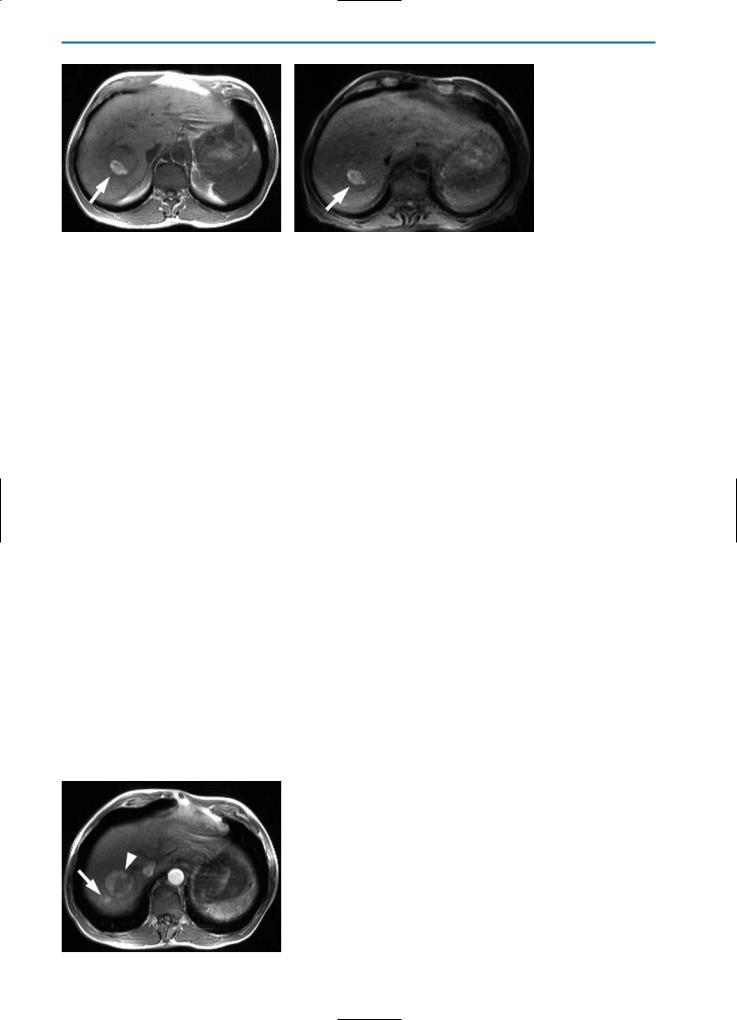
11 • Imaging of the Liver Post-Surgery and/or Post-Ablative Therapy |
385 |
a |
b |
Fig. 11a, b. T1-weighted (a) and T1-weighted fat-suppressed (b) imaging of an HCC within the first week after TACE.
Increased SI is seen within the treated tumor nodule due to accumulation of lipiodol (arrows). This can make it difficult to detect residual hypervascular tumor tissue on dynamic Gd-enhanced liver imaging
trast-enhanced T1-weighted MRI performed two to three months after therapy is very sensitive for detecting or excluding recurrent tumors. Typically, a reduction of the T2 relaxation time, resulting in a decrease of signal intensity, can be observed in completely destroyed tumors on T2-weighted images acquired two to three months post-TACE. At this time-point, the decreased T2-weighted signal intensity is more likely to be a result of coagulative necrosis induced by TACE than an effect of lipiodol [15].
Completely destroyed tumors are similarly depicted as areas of low signal intensity on T1weighted images. Thus, dynamic imaging after the injection of Gd-based contrast agents is very sensitive for the detection of tumor recurrence, especially in hypervascular lesions such as HCC, since good contrast between the necrosis and viable tumor can be achieved (Fig. 12). Two to three months after treatment, areas of high signal intensity on T2-weighted images and hypervascular areas on contrast-enhanced T1-weighted dynamic arterial phase images can be considered as indicative of tumor recurrence [4, 31].
11.7
Multimodality Treatment of Hepatic Lesions
Only about 30% of patients with hepatic metastatic disease are suitable for hepatic resection. The majority of patients with liver metastases or primary malignant liver tumors are not candidates for this therapeutic approach due to advanced hepatic tumor spread [1]. To overcome this dilemma, a multi-modality treatment approach involving combined surgical, interventional, focal ablative and chemotherapeutic methods has been proposed to achieve a better five year patient survival.
With the development of focal ablative procedures, including local application of cold, heat, or drugs to destroy tumor tissue, a functional tissue sparing method has been developed. In patients with bilobar tumor spread, these new techniques allow for a combined therapeutic approach with open surgical liver resection of one liver lobe,in combination with focal ablative therapies such as cryotherapy,laseror radio-frequency induced thermal tumor destruction in the contralateral lobe in order to pre-
Fig. 12. Recurrent HCC post-TACE. Three months post-TACE therapy of an HCC, recurrent hypervascularization of the treated area is visible (arrowhead) on a T1weighted arterial phase image after Gd-injection. In addition, a satellite lesion adjacent to the treated lesion is visible (arrow)
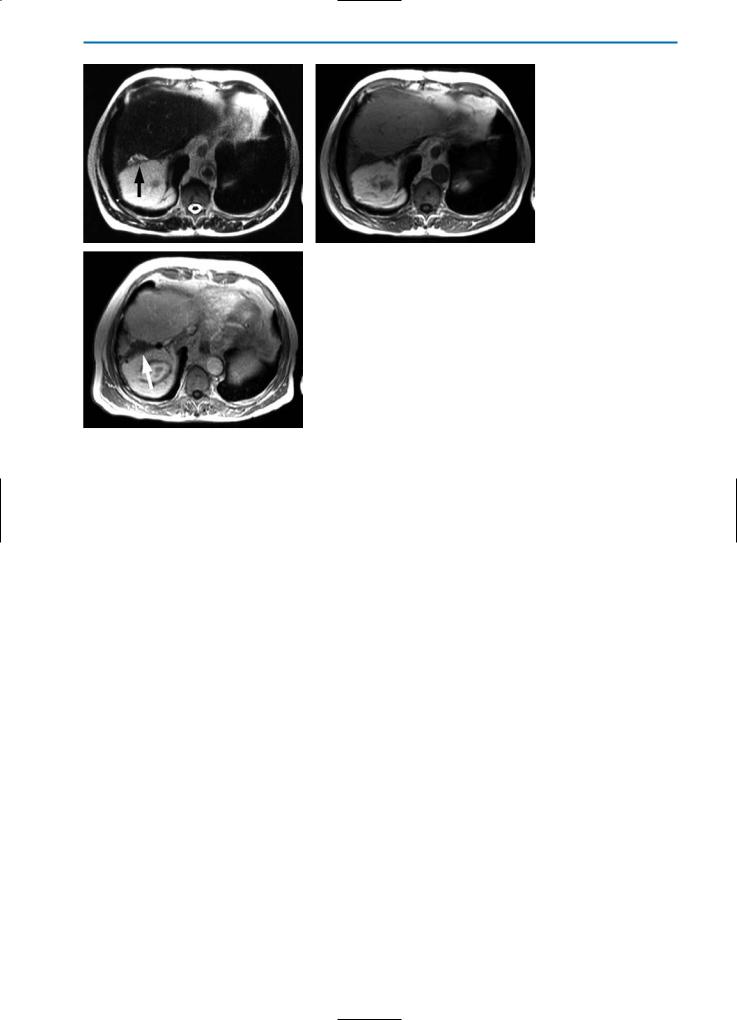
386 MRI of the Liver
a |
b |
Fig. 13a-c. Cryotherapy of the resection edge during atypical liver resection. The T2-weighted unenhanced image (a) shows a decreased size of the liver due to hemihepatectomy and additional atypical resections of metastases. To spare as much residual liver tissue as possible, the actual resection was performed with a small resection margin with concomitant cryotherapy of the resection margins (black arrow). On the unenhanced T1-weighted image (b) the lesion shows low SI. On the T1weighted equilibrium phase image (c) after contrast agent injection the lesion
c(white arrow) is sharply demarcated from surrounding liver tissue. No signs of residual or recurrent tumor tissue are visible
serve the functional surrounding liver tissue [36, 37]. To achieve this objective, precise pretherapeutic imaging is necessary to characterize the tumor’s location, size and segmental distribution, in order to allow accurate planning of the therapeutic strategy. In some cases the calculation of tumor volume in relation to residual liver parenchyma might be helpful to determine the post-operative outcome in terms of liver function [38]. The method of intraoperative or interventional preconditioning of one liver lobe, for example,gives a better functional result after hepatic resection or thermal therapy [39]. The liver lobe to be preserved can be stimulated to regenerate by selective interventional occlusion of one portal venous branch on the opposite side. The volume increase can be detected precisely by MR volume calculation [38, 40].
Surgical resection of hepatic tumors should be performed if the lesion is surrounded by healthy liver tissue in order to leave a resection safety margin of 1 cm. Tumor locations near larger blood vessels or bile duct structures may make it difficult to achieve this safety margin. Therefore, cryotherapy of the resection edge with a specially designed flattened cryo-probe can be performed as a therapeutic adjunct to achieve tumor-free resection margins [41-43]. On post-operative MR imaging the resulting cryonecrosis is characterized by a flattened elliptical area (Fig. 13) with identical peripheral imaging features as endohepatic cryotherapy. Criteria for detection of residual tumor should be applied analogously.
In the large proportion of patients not suitable for curative treatment, systemic or intra-ar- terial chemotherapy has been established as a second-line therapy to achieve prolonged patient survival. Nevertheless, the five year survival of patients with colorectal carcinoma undergoing conventional chemotherapeutic treatment with 5-fluorouracil and leucovorin has proven to be very poor [44]. Newer strategies using a combination of irinotecan, oxaliplatin and modified delivery regimes have demonstrated better response rates [45]. This improved efficacy not only results in prolonged patient survival, but in some patients also offers the possibility of a curative treatment by surgery after down-staging [46]. Another strategy of preinterventional tumor downsizing is neoadjuvant transarterial chemoembolization. With the combination of chemotherapeutic drugs (e.g. mitomycin) and embolization materials such as microspheres and lipiodol, a significant reduction in tumor volume is possible which then allows treatment options with curative intention, such as surgical resection or focal ablative techniques. Nevertheless, further prospective randomized trials are needed to evaluate this strategy [24]. In this setting, MRI plays an important role in characterizing tumor volume and perfusion before and after neoadjuvant therapy in order to accurately evaluate the effectiveness of treatment and to evaluate the possibility of subsequent curative treatment.

11 • Imaging of the Liver Post-Surgery and/or Post-Ablative Therapy |
387 |
References
1. Bown SG. Phototherapy in tumors. World J Surg
1983; 7:700-9
2. Braga L, Semelka RC, Pedro MS, et al. Post-treat- ment malignant liver lesions. MR imaging. Magn Reson Imaging Clin N Am 2002; 10:53-73
3. Chen HS, Gross JF. Intra-arterial infusion of anticancer drugs: theoretic aspects of drug delivery and review of responses. Cancer Treat Rep 1980; 64:31-40 4. De Santis M, Torricelli P, Cristani A, et al. MRI of hepatocellular carcinoma before and after transcatheter chemoembolization. J Comput Assist To-
mogr 1993; 17(6):901-8
5. De Santis M, Alborino S, Tartoni PL, Torricelli P, Casolo A, Romagnoli R. Effects of lipiodol retention on MRI signal intensity from hepatocellular carcinoma and surrounding liver treated by chemoembolization. Eur Radiol 1997; 7:10-6
6. Desinger K, Stein T, Tschepe J, Müller G. Investigation on radio-frequency current application in bipolar technique for interstitial thermotherapy (RFITT). Minim Invasive Med 1996; 7:92-97
7. Dromain C, de Baere T, Elias D, et al. Hepatic tumors treated with percutaneous radio-frequency ablation: CT and MR imaging follow-up. Radiology
2002; 223:255-62
8. Ebara M, Ohto M, Sugiura N, Kita K, Yoshikawa M, Okuda K, Kondo F, Kondo Y. Percutaneous ethanol injection for the treatment of small hepatocellular carcinoma. Study of 95 patients. J Gastroenterol Hepatol 1990; 5(6):616-26
9. Gayowski TJ, Iwatsuki S, Madariaga JR, Selby R, Todo S, Irish W, Starzl TE. Experience in hepatic resection for metastatic colorectal cancer: analysis of clinical and pathologic risk factors. Surgery 1994; 116(4):703-10; discussion 710-711
10. Lee F, Bahn DK, McHugh TA, Onik GM, Lee FT Jr. US-guided percutaneous cryoablation of prostate cancer.Radiology 1994; 192(3):769-76
11. Lencioni R, Bartolozzi C, Caramella D, Di Coscio G. Management of adenomatous hyperplastic nodules in the cirrhotic liver: US follow-up or percutaneous alcohol ablation? Abdom Imaging 1993; 18(1):50-5
12. McCarter MD, Fong Y. Metastatic liver tumors. Semin Surg Oncol 2000; 19(2):177-88
13. Murakami T, Nakamura H, Tsuda K, Nakanishi K, Hori S, Tomoda K, Mitani T, Kozuka T, Monden M, Wakasa K. Treatment of hepatocellular carcinoma by chemoembolization: evaluation with 3DFT MR imaging. AJR Am J Roentgenol 1993; 160(2):295-9
14. Pentecost MJ. Transcatheter treatment of hepatic metastases. AJR Am J Roentgenol 1993; 160(6):1171-5 15. Sakurai M, Okamura J, Kuroda C. Transcatheter chemo-embolization effective for treating hepatocellular carcinoma. A histopathologic study. Cancer
1984; 54(3):387-92
16. Shiina S, Tagawa K, Niwa Y, Unuma T, Komatsu Y, Yoshiura K, Hamada E, Takahashi M, Shiratori Y, Terano A, et al. Percutaneous ethanol injection therapy for hepatocellular carcinoma: results in 146 patients. AJR Am J Roentgenol 1993; 160(5):1023-8
17. Sironi S, De Cobelli F, Livraghi T, Villa G, Zanello A, Taccagni G, DelMaschio A. Small hepatocellular carcinoma treated with percutaneous ethanol injection: unenhanced and gadolinium-enhanced MR imaging follow-up. Radiology 1994; 192(2):407-12
18. Solbiati L, Goldberg SN, Ierace T, Livraghi T, Meloni F, Dellanoce M, Sironi S, Gazelle GS. Hepatic metastases: percutaneous radio-frequency ablation with cooled-tip electrodes. Radiology 1997; 205(2):367-73 19. Stangl R, Altendorf-Hofmann A, Charnley RM, Scheele J. Factors influencing the natural history of colorectal liver metastases. Lancet 1994;
343(8910):1405-10
20. Steele G Jr. Cryoablation in hepatic surgery. Semin Liver Dis 1994; 14(2):120-5
21. Vogl TJ, Muller PK, Mack MG, Straub R, Engelmann K, Neuhaus P. Liver metastases: interventional therapeutic techniques and results, state of the art. Eur Radiol 1999; 9(4):675-84
22. Vogl TJ, Mack MG, Muller PK, Straub R, Engelmann K, Eichler K. Interventional MR: interstitial therapy. Eur Radiol 1999; 9(8):1479-87
23. Puls R, Stroszczynski C, Gaffke G, Hosten N,Felix R, Speck U. Laser induced thermotherapy (LITT) of liver metastases: MR guided percutaneous insertion of an MRI-compatible irrigated microcatheter system using a closed high field unit. J Magn Reson Imaging 2003; 17:663-670
24. Vogl TJ, Mack MG, Balzer JO, Engelmann K, Straub R, Eichler K, Woitaschek D, Zangos S. Liver metastases: Neoadjuvant downsizing with transarterial chemoembolization before laser induced thermotherapy. Radiology 2003; 229:457-464
25. Isbert C, Ritz JP, Schilling A, Roggan A, Heiniche A, Wolf KJ, Müller G, Buhr HJ, Germer CT. Laser induced thermotherapy (LITT) of experimental liver metastasis-Detection of residual tumor using Gd-DT- PA enhanced MRI. Lasers Surg Med 2002; 30:280-289
26. Tacke J, Adam G, Haage P, Sellhaus B, Großkortenhaus S, Günther RW. MR-guided percutaneous cryotherapy of the liver: In vivo evaluation with histologic correlation in an animal model. J Magn Reson Imaging 2001; 13:50-56
27. Butts K, Sinclair J, Daniel BL, Wansapura J, Pauly J. Temperature quantitation and mapping of frozen tissue. J Magn Reson Imaging 2001; 13:99-114
28. Mala T, Edwin B, Tillung T, Hol PC, Soreide O, Gladhaug I. Percutaneous cryoablation of colorectal liver metastases: potentiated by two consecutive freeze-thaw cycles. Cryobiology 2003; 46:99-102
29. Fujita T, Honjo K, Ito K, Arita T, Koike S, Takano S, Tamura S, Matsumoto T, Matsunaga N. Fan-shaped hepatic parenchymal damage after ethanol injection therapy for hepatocellular carcinoma: MRI appearances. Abdom Imaging 1999; 24:56-60
30. Maataoui A, Qian J, Vossoughi D, Khan MF, Oppermann E, Bechstein WO, Vogl TJ. Transarterial chemoembolisation alone and in combination with other therapies: A comparative study in an animal model. Eur Radiol 2005; 15:127-133
31. Guang YS, Sun L, Zhou XP, Li Xiao, Zheng XH. Hepatocellular carcinoma treated with interventional procedures: CT and MRI follow-up. World J Gastroenterol 2004; 10:3546-3548
32. Sasson AR, Sigurdson ER. Surgical treatment of liver metastases. Semin Oncol 2002; 29:107-118
33. Lencioni R, Crocetti L, Cioni D, Della Pina C, Bartolozzi C. Percutaneous radiofrequency ablation of hepatic colorectal metastases: Technique, indications, results and new promises. Invest Radiol 2004;
39:689-697
34. Antoch G, Vogt FM, Veit P, Freudenberg L, Blech-

388 MRI of the Liver
schmid N, Dirsch O, Bockisch A, Forsting M, Debatin J, Kuehl H. Assessment of liver tissue after radiofrequency ablation: Findings with different imaging procedures. J Nucl Med 2005; 46:520-525
35. Dromain C, De Baere T, Elias D, Kuoch V, Ducreux M, Boige V, Petrow P, Roche A, Sigal R. Hepatic tumors treated with percutaneous radio-frequency ablation : CT and MR imaging follow up. Radiology
2002; 223:255-262
36. Brooks AJ, Wang F, Alfredson M, Yan TD, Morris DL. Synchronous liver resection and cryotherapy for colorectal metastases: survival analysis. Surgeon
2005; 3(4):265-8
37. Seifert JK, Springer A, Baier P, Junginger T. Liver resection or cryotherapy for colorectal liver metastases A prospective case control study. Int J Colorectal Dis 2005; 20(6):507-20
38. Vogl TJ, Straub R, Eichler K, Sollner O, Mack MG. Colorectal carcinoma metastases in liver: laser-in- duced interstitial thermotherapy–local tumor control rate and survival data. Radiology 2004;
230(2):450-8
39. Banga NR, Homer-Vanniasinkam S, Graham A, Al-
Mukhtar A, White SA, Prasad KR. Ischaemic preconditioning in transplantation and major resection of the liver. Br J Surg 2005; 92(5):528-38
40. Liu H, Fu Y. Portal vein embolization before major hepatectomy. World J Gastroenterol 2005;
11(14):2051-4
41. Gananadha S, Daniel S, Zhao J, Morris DL. An experimental evaluation of ablation devices for the local treatment of the liver resection edge. Eur J Surg Oncol. 2005; 31(5):528-32
42. Shen P, Hoffman A, Howerton R, Loggie BW. Cryosurgery of close or positive margins after hepatic resection for primary and metastatic hepatobiliary malignancies. Am Surg 2002; 68(8):695-703
43. Gruenberger T, Jourdan JL, Zhao J, King J, Morris DL. Reduction in recurrence risk for involved or inadequate margins with edge cryotherapy after liver resection for colorectal metastases. Arch Surg 2001;
136(10):1154-7
44. Stangl R, Altendorf-Hofmann A, Charnley RM, Scheele J. Factors influencing the natural history of colorectal liver metastases. Lancet 1994;
343(8910):1405-10
